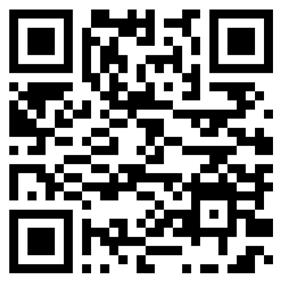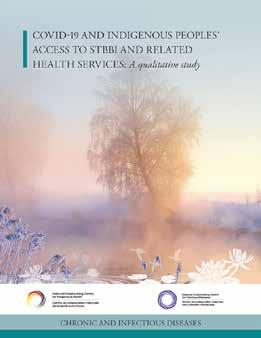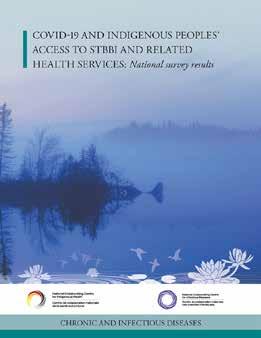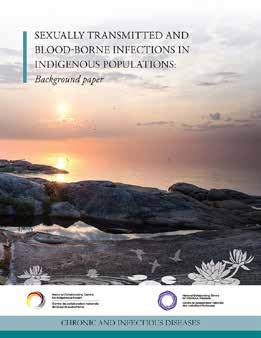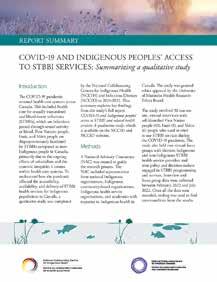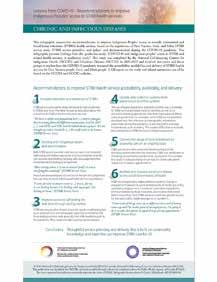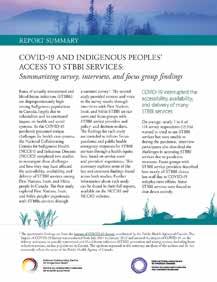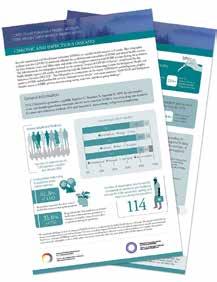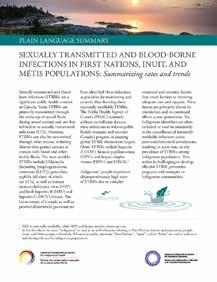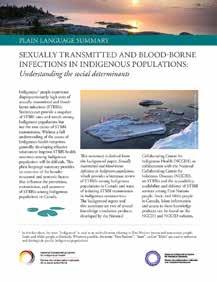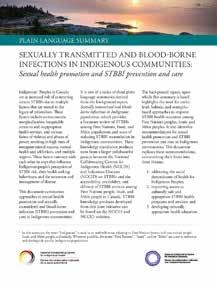
PLAIN LANGUAGE SUMMARY
SEXUALLY TRANSMITTED AND BLOOD-BORNE INFECTIONS IN INDIGENOUS COMMUNITIES:
Sexual health promotion and STBBI prevention and care
Indigenous 1 Peoples in Canada are at increased risk of contracting certain STBBIs due to multiple factors that are rooted in the legacy of colonialism. These factors include socioeconomic marginalization, inequitable access to and inappropriate health services, and various forms of violence and abuses of power, resulting in high rates of intergenerational trauma, mental health and addictions, and multiple stigmas. These factors intersect with each other in ways that influence Indigenous people’s perception of STBBI risk, their health seeking behaviours, and the treatment and management of disease.
This document summarizes approaches to sexual health promotion and sexually transmitted and blood-borne infection (STBBI) prevention and care in Indigenous communities.
It is one of a series of three plain language summaries derived from the background report, Sexually transmitted and bloodborne infections in Indigenous populations, which provides a literature review of STBBIs among First Nations, Inuit, and Métis populations and ways of reducing STBBI transmission in Indigenous communities. These knowledge translation products stem from a larger collaborative project between the National Collaborating Centres for Indigenous Health (NCCIH) and Infectious Diseases (NCCID) on STBBIs and the accessibility, availability, and delivery of STBBI services among First Nations people, Inuit, and Métis people in Canada. STBBI knowledge products developed from this joint initiative can be found on the NCCIH and NCCID websites.
The background report, upon which this summary is based, highlights the need for multilevel, holistic, and strengthsbased approaches to improve STBBI health outcomes among First Nations peoples, Inuit, and Métis peoples. It also identifies recommendations for sexual health promotion and STBBI prevention and care in Indigenous communities. This document explores these recommendations, summarizing their focus into three themes:
1. addressing the social determinants of health for Indigenous Peoples;
2. improving access to culturally safe and appropriate STBBI health programs and services; and
3. developing culturally appropriate health education.
1 In this summary, the term “Indigenous” is used as an umbrella term referring to First Nations (status and non-status) people, Inuit, and Métis people, collectively. Wherever possible, the terms “First Nations”, “Inuit”, and/or “Métis” are used to reference and distinguish specific Indigenous populations.
This summary concludes by highlighting some promising initiatives in STBBI prevention, testing, and care that have worked well in Indigenous contexts.
Addressing the social determinants of health for Indigenous people
Literature suggests that STBBI prevention is most effective when approaches address the underlying factors that increase the risk of STBBI infection among Indigenous people. These factors are structural and systemic and rooted in the social determinants of health. There is a need to address the social determinants of health in STBBI education and prevention, specifically, as well as the upstream social and systemic factors that contribute to Indigenous health inequities, generally.
Within the context of STBBI education and prevention, recommendations include a need to improve education and literacy among Indigenous populations, particularly around STBBIs and the importance of prevention. This is critical for addressing STBBI-related stigma, dispelling myths around STBBIs, increasing risk awareness, and promoting personal resiliency. STBBI prevention interventions

must provide education about social exclusion, racism, and discrimination, and their impacts on health, as well as foster youth leadership to increase awareness about STBBIs and ways to reduce transmission. Interventions must work to strengthen social support networks to improve mental health and self-esteem. They must also address the social contexts of the multiple, intersecting stigmas that can cause Indigenous people diagnosed or living with STBBIs to experience shame and social isolation. Ensuring that health care providers are nonjudgmental, have knowledge about LGBTQ2S+ 2 sexual
© Credit: iStockPhoto.com
health issues, can provide accurate and relevant sexual health information, and take all necessary precautions to maintain patient confidentiality can help Indigenous patients feel comfortable accessing STBBI-related services. It can also improve trust in the healthcare system and reduce feelings of social isolation. Moreover, providing access to free condoms in a nonstigmatizing environment can help to address barriers linked to poverty, as well as concerns about the confidentiality of STBBI prevention services.
2 LGBTQ2S+ is an acronym for lesbian, gay, bisexual, trans, queer, two-spirit, and other sexual orientations and gender identities.
A robust body of literature details the need for STBBI services to be trauma-informed and culturally safe. Trauma-informed and culturally safe care can be promoted through diverse actions relating to organizational culture, physical space, and provider-client interactions. Working through such mediums can foster an environment that reduces the harms of trauma on clients’ health and well-being; ensures physical spaces are comfortable, inviting, and welcoming; and promotes provider-client relationships that are based on trust and encourage patient choice, collaboration, and connection. Literature suggests that STBBI services and care should be grounded in Indigenous ways of knowing and incorporate holistic physical, mental, and spiritual health and well-being alongside Western models of care. Such approaches have been found to promote health and healing for Indigenous people diagnosed with chronic STBBIs, like HIV and hepatitis C.
Access to culturally safe and appropriate sexual health programs and services can also be improved by building health system capacity. This includes training healthcare providers to integrate STBBI education and prevention into clinic visits for other services and enhance their ability to practice trauma-
informed care. Mandatory and ongoing cultural safety training can also enhance healthcare providers’ understanding of how determinants of health and racism affect risk taking and help-seeking behaviours. Additionally, health system capacity can be built by implementing innovative sexual health service provision models that address current health service challenges.
Examples of these models include:
extending mobile sexual health clinics through partnerships with public health organizations and Indigenous communities; adopting harm reduction approaches that link sexual health screening with mental health and addiction services; bringing testing, education, diagnostic, and treatment services, like point of care testing (POCT), into communities; and creating more urbanbased, Indigenous-led organizations to focus on STBBI prevention and providing them with sustainable funding and enhanced mandates to facilitate greater access to culturally appropriate sexual health information and services for urban Indigenous populations.
Developing culturally appropriate health education
Literature suggests there is a general lack of knowledge among many Indigenous people about STBBIs, how to prevent them, and the benefits of screening. This lack of knowledge contributes to the ongoing stigma and shame associated with sexual health, which results in delayed health seeking behaviour and poorer health outcomes. Indigenous communities need more information to foster conversations about sexual health, which has been shown to be lacking particularly in rural, remote, and northern regions. It is best that this information be provided before youth become sexually active and continue to be provided throughout a person’s life course to promote a culture of routine screening. Sexual health education should occur in a variety of settings and be comprehensive, including a focus on changing sexual health behaviours, beliefs, and practices of individuals, and enhancing knowledge about STBBIs and prevention. STBBI-related education should be culturally appropriate, accessible, and tailored to meet the diverse needs of Indigenous people and the unique realities they face.
Currently, there are gaps in knowledge on what works best in sexual health education programs, what the educational needs are of specific Indigenous populations (e.g., cisgender men, members of the LGBT2S+ community, First Nations, Inuit, and Métis), and how to overcome barriers to key prevention strategies (e.g., regular use of condoms, treatment adherence, regular screening). There is some recognition that Elders need to be re-engaged in cross-generational health promotion and education; however, Elders require language tools to support them in this process. There are often no Indigenous words for specific sexual health terminology and many Indigenous languages, particularly Inuit languages, do not contain past and future tenses. There is also acknowledgement that health education for youth should focus on their rights to contraception and choice about its use, as well as the need to prevent gender-based violence.
Literature recognizes the need to normalize discourse around sexual health, STBBIs, and testing in Indigenous communities to reduce stigma and fear and encourage more consistent testing. Some promising practices identified in the literature include: incorporating traditional knowledges and approaches to healing in conjunction with Western therapies; emphasizing positive and supportive health messaging that promotes resilience;
∙ targeting comprehensive sexual health education to select groups at increased risk, as well as to all community members, to reduce shame and stigma associated with STBBIs, build STBBI knowledge and skills, and facilitate communication with youth on sex-related topics; having sexual health education delivered by workers who closely resemble target clients, such as peers and individuals
with shared life experiences, or by Elders; and
∙ incorporating methods that target hard-to-reach populations such as outreach programs for youth who do not attend school.
The literature also reveals some innovative, effective, and practical ways to deliver sexual health education to Indigenous populations. These include implementing social marketing campaigns and using various forms of social media as sexual health education tools; employing arts-based methods to teach life skills and enhance self-help skills (e.g. communication and negotiation skills); using rolemodelling to demonstrate healthy intimate relationships; hosting sexual health fairs; conducting STBBI screening campaigns; integrating sexual health education into summer sports camps; and modelling learned skills in education.
Promising initiatives in STBBI prevention, testing, and care
The literature highlights several examples of initiatives that have shown promise in STBBI prevention, testing, and care that can be built on. These include:
STBBI prevention
∙ “Know your Status” campaign, implemented across Saskatchewan to prevent and reduce HIV and hepatitis C transmission, while connecting individuals to appropriate care and services.
∙ Extension for Community Health Outcomes (ECHO+) telehealth outreach model, implemented by the Province of Alberta to enhance equitable access to hepatitis C care for Indigenous populations.
∙ Trauma-informed and artsbased culturally appropriate prevention programs such as the Taking Action! Human Immunodeficiency Virus Prevention Project, first undertaken between 2007 and 2010 by a researcher at York University, in collaboration with the Canadian Aboriginal AIDS Network, followed by Taking Action II, co-led by the same researcher in collaboration with youth leadership from the Native Youth Sexual Health Network; the Sexy Health Carnival – a peer-led initiative
pilot-tested in four on-reserve First Nations communities in Ontario; the Fostering Open eXpression among Youth (FOXY) program for young women and gender diverse youth in northern Canada; and Strength, Masculinities, and Sexual Health (SMASH) program, a parallel program for young men in the Northwest Territories.
∙ The Ahkwesáhsne Mohawk Nation’s Oheró:kon – Under the Husk (Rights of Passage) program which emphasizes strengthening relationships and reconnecting to Indigenous cultures and rites of passage.
STBBI testing and care
∙ Point-of-care testing in Indigenous communities.
∙ Self-testing or testing methods that can be administered by trained community members (e.g., dried blood spot testing) where samples are shipped to a laboratory for testing. Alternative service delivery options, such as mobile clinics and telehealth STBBI testing and treatment services.
∙ Incentivized STBBI testing methods, such as small financial compensation for testing and follow-up visits.
Each of these testing methods requires sustained, culturally appropriate, and safe followthrough care and treatment for those who receive a positive result.


